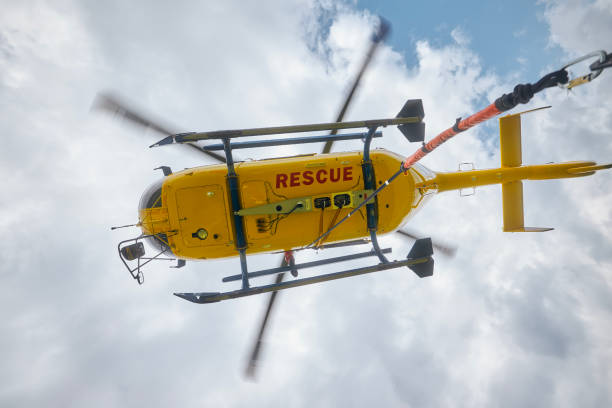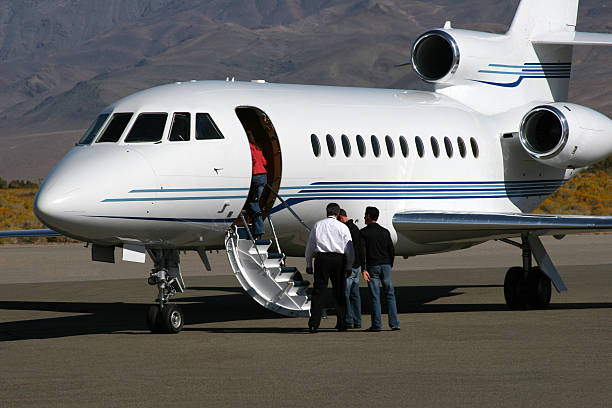Fastest MEDEVAC Flight Coordination in Phoenix: How Expert Planning Saves Lives Through Rapid Response Aviation

When medical emergencies strike in the Phoenix metropolitan area, every second counts toward connecting patients with life-saving care. Medical evacuation (MEDEVAC) services represent the critical bridge between emergency scenes and specialized medical facilities, requiring precise coordination with FAA-certified operators who conduct helicopter air ambulance operations under strict Part 135 requirements. Phoenix, Arizona's fifth-largest city with over 1.7 million residents, relies on sophisticated flight coordination expertise to ensure the fastest possible emergency medical response times across the sprawling Sonoran Desert landscape.
At ParaFlight, we specialize in coordinating these critical medical transportation services by connecting families and medical facilities with qualified, FAA-certified air medical operators throughout the Phoenix region. Our expert-driven approach ensures seamless coordination when minutes matter most.
Understanding MEDEVAC Flight Coordination Excellence in Phoenix
Medical evacuation flight coordination involves orchestrating a complex network of emergency medical services, FAA Part 135 certified aviation operators, hospital systems, and communication centers working in perfect synchronization. In Phoenix, this intricate coordination system serves not only the metropolitan area but extends across rural Arizona, where ground transportation to major medical facilities can take hours.
The Phoenix MEDEVAC system operates under strict Federal Aviation Administration (FAA) guidelines, with aircraft using the "MEDEVAC" designation to receive priority handling from air traffic controllers. This coordination extends to Phoenix Sky Harbor International Airport, one of the busiest airports in the United States handling over 44 million passengers annually.
The Critical Timeline: Understanding Emergency Response
The first 60 minutes after traumatic injury has been termed the "golden hour," a concept that has been taught and practiced for more than 3 decades. However, recent scientific evidence suggests the "golden hour" concept is pervasive despite little evidence to support it. Research indicates that median emergency response times from 911 call to hospital arrival average 36.3 minutes across diverse North American locations.
In Phoenix's urban sprawl covering over 500 square miles, ground ambulances face significant challenges including traffic congestion, distance to trauma centers, and harsh desert conditions. Medical evacuation operations provide rapid response capabilities, with helicopters offering agility for urban areas and rugged terrain access.
Phoenix's MEDEVAC Infrastructure and Certified Operators
Working with FAA-Certified MEDEVAC Providers
Phoenix benefits from multiple FAA-certified MEDEVAC operators, each maintaining strategically positioned aircraft throughout the metropolitan area. ParaFlight coordinates with these certified operators to ensure optimal coverage and response capabilities.
These certified operators maintain aircraft equipped with advanced life support equipment and staffed by experienced flight nurses and paramedics who meet stringent certification requirements including nationally registered EMT-P status, extensive critical care experience, and current ACLS, ITLS, CPR, and PALS certifications.
State-of-the-Art Medical Aircraft Standards
Modern MEDEVAC helicopters are specialized aircraft equipped with medical equipment and personnel to swiftly transport patients to hospitals or trauma centers. These FAA-certified aircraft feature:
- Advanced cardiac monitoring systems
- Ventilators and airway management tools
- Blood and medication storage capabilities
- Satellite communication systems for real-time medical consultation
- Night vision capabilities for 24/7 operations
- GPS navigation systems with hospital landing zone databases
The Phoenix Advantage: Geographic and Operational Benefits
Optimal Flying Conditions for Emergency Operations
Phoenix's desert climate provides significant advantages for MEDEVAC operations. With over 300 sunny days annually and minimal precipitation, weather-related flight restrictions are less common compared to other major metropolitan areas. FAA regulations require certified operators to obtain weather reports from approved sources within 15 nautical miles of airports for safe operations.
Strategic Hospital Network Integration
Phoenix's trauma care system includes several Level I trauma centers equipped with helipads designed for rapid patient transfer. The city's medical infrastructure supports seamless integration between air and ground emergency services through coordinated planning.
Advanced Communication and Expert Coordination Systems
Unified Emergency Response Through Expert Planning
Phoenix's MEDEVAC coordination relies on sophisticated communication systems connecting multiple agencies through expert coordination services like ParaFlight:
911 Emergency Dispatch Centers immediately assess situations requiring air medical transport, considering factors such as injury severity, location accessibility, and hospital capacity.
Flight Operations Centers coordinate with FAA-certified operators for aircraft deployment, weather monitoring, and air traffic control communications to ensure optimal flight paths and minimal response times.
Hospital Communication Networks provide real-time updates on trauma bay availability, specialist coverage, and landing zone conditions.
Technology Integration in Coordination Services
Modern MEDEVAC coordination utilizes advanced technology including:
- Automated vehicle location (AVL) systems tracking emergency response assets
- Computer-aided dispatch (CAD) systems providing instant access to medical facility capabilities
- Weather monitoring systems providing real-time atmospheric conditions
- GPS-based navigation with obstacle databases for safe low-altitude flight operations
Response Time Performance and Industry Standards
According to the Association of Air Medical Services (AAMS), established in 1980, the organization is dedicated to advancing transport medicine through advocacy, education, and research to ensure high-quality, life-saving care. Industry benchmarks suggest optimal response targets, though actual performance varies by location and circumstances.
Estimated optimal MEDEVAC response goals include:
- Dispatch to airborne: Under 8 minutes (industry estimate)
- Scene response time: 15-20 minutes for urban areas (estimated)
- Patient transport time: Minimized through strategic hospital selection
- Total response time: Under 30 minutes for most metropolitan emergencies (estimated)
Note: These are industry estimates and actual response times may vary based on numerous factors including weather, aircraft availability, and specific circumstances.
Challenges and Solutions in Desert MEDEVAC Operations
Environmental Considerations for Certified Operators
Operating MEDEVAC services in Phoenix's Sonoran Desert environment presents unique challenges for FAA-certified operators:
Temperature Extremes: Summer temperatures exceeding 120°F affect aircraft performance and require specialized procedures. FAA regulations require pilots to demonstrate familiarity with local flying areas through examination within 12 months.
Dust and Visibility: Desert dust storms (haboobs) can rapidly reduce visibility, requiring sophisticated weather monitoring and alternative transport protocols.
Terrain Obstacles: Phoenix's mountainous terrain requires specialized navigation capabilities and obstacle avoidance systems for safe operations.
Urban Aviation Coordination Challenges
Phoenix's rapid urban development creates ongoing coordination challenges:
Infrastructure Complexity: Extensive electrical infrastructure requires detailed mapping and specialized navigation for safe low-altitude operations.
Traffic Considerations: While helicopters avoid ground traffic, landing zone access coordination can be complicated by traffic patterns.
Community Integration: Balancing rapid response requirements with community considerations requires careful flight path planning.
Training and Certification Excellence Standards
Medical Crew Certification Requirements
Phoenix MEDEVAC operations maintain strict medical staffing standards, with flight nurses requiring critical care experience and advanced certifications, while flight paramedics need extensive advanced life support experience and specialized equipment training.
Transport nursing represents a unique and expanded role encompassing air and surface medical transport of critically ill and injured patients.
Pilot Certification Standards
MEDEVAC pilots must meet stringent FAA requirements including commercial or airline transport pilot licenses with instrument ratings, with dispatcher certifications preferred. Additional requirements typically include:
- Minimum flight hours with significant helicopter experience
- Instrument flight rating with night vision qualifications
- Mountain flying experience and desert operation familiarity
- Regular recurrent training in emergency procedures
Integration with Regional Emergency Systems Through Expert Coordination
Multi-State Coordination Capabilities
Phoenix's MEDEVAC system frequently requires coordination with neighboring states for specialized care transfers. Patients requiring treatment unavailable in Phoenix may need transport to facilities in California, Colorado, or Utah, requiring complex inter-state medical transport coordination expertise.
Rural Arizona Coverage Extension
Phoenix-based coordination services extend coverage throughout rural Arizona, where ground transport distances to trauma centers can exceed 200 miles. This coordination requires:
- Extended range capability planning
- Communication with remote landing zones
- Coordination with volunteer emergency services
- Weather monitoring across diverse geographic regions
Quality Assurance and Continuous Improvement
Performance Monitoring Systems
AAMS advocates on behalf of the medical transport community to ensure sustainability, increase medical quality and patient safety. Quality assurance programs include:
Response Time Analysis: Continuous monitoring of coordination efficiency and transport effectiveness.
Safety Management Systems: Comprehensive safety programs tracking incidents and implementing preventive measures.
Outcome Assessment: Following coordination effectiveness to improve future response planning.
Future Innovation in Coordination Technology
Phoenix MEDEVAC coordination services are preparing for emerging technologies:
Enhanced Communication Networks: Future 5G-enabled capabilities may provide improved connectivity between coordination centers and medical facilities.
Predictive Analytics: Data-driven systems for demand pattern prediction and optimal resource positioning are being developed.
Autonomous Systems Integration: Future autonomous flight systems may enhance safety and operational efficiency, though these remain in development phases.
Economic Impact and Community Benefits
Healthcare System Integration Benefits
Expert MEDEVAC coordination provides significant benefits to Phoenix's healthcare system:
- Improved emergency department efficiency through strategic patient distribution
- Enhanced trauma center utilization optimization
- Reduced coordination complexity for hospital staff
- Streamlined communication between multiple providers
Community Safety Enhancement
Professional MEDEVAC coordination services enhance overall community safety by ensuring rapid access to qualified, FAA-certified operators when emergencies occur. This coordination infrastructure supports Phoenix's continued growth and development.
Future Developments in Phoenix MEDEVAC Coordination
Emerging Technologies on the Horizon
Phoenix MEDEVAC coordination is monitoring technological advances for future integration:
Electric Aircraft Development: Research into electric MEDEVAC helicopters may offer reduced operating costs and environmental impact in the future.
Unmanned Systems Research: Development of drone technology for medical supply delivery and scene assessment remains in experimental phases.
AI-Enhanced Coordination: Artificial intelligence applications for coordination optimization are being researched, though not yet operationally deployed.
Expansion and Growth Planning
As Phoenix continues rapid population growth, coordination services are expanding:
- Enhanced coordination capabilities with additional certified operators
- Improved integration with emerging hospital systems
- Expanded coverage areas serving Arizona's growing population
- Advanced training and coordination capabilities
The ParaFlight Advantage: Expert-Driven MEDEVAC Coordination
Why Choose Professional Coordination Services
ParaFlight's expert-driven coordination model provides several key advantages:
Exclusive Partnership with FAA-Certified Operators: We work only with fully certified, compliant operators who meet the highest safety and operational standards.
24/7 Expert Coordination: Our experienced team provides round-the-clock coordination services, ensuring rapid response when emergencies occur.
Comprehensive Network Access: Through our established relationships with certified operators, we can coordinate the most appropriate aircraft and crew for each specific situation.
Regulatory Compliance Assurance: Our expertise ensures all coordinated flights meet FAA requirements and industry safety standards.
Our Coordination Process
When you contact ParaFlight for MEDEVAC coordination in Phoenix:
- Immediate Assessment: Our experts rapidly assess your specific medical transportation needs
- Operator Selection: We coordinate with the most appropriate FAA-certified operator for your situation
- Comprehensive Planning: We handle all coordination details including hospital communication, flight planning, and regulatory compliance
- Ongoing Support: We provide continuous coordination support throughout the entire transport process
Conclusion: Excellence in MEDEVAC Coordination When Lives Depend on It
Phoenix's MEDEVAC coordination success depends on expert planning, qualified operators, and sophisticated coordination systems working together seamlessly. By leveraging aviation assets and specialized medical expertise, these services facilitate timely access to critical care and enhance outcomes for patients in need through seamless coordination between healthcare providers, aviation professionals, and emergency responders.
ParaFlight's commitment to coordinating exclusively with FAA-certified operators ensures Phoenix residents and visitors receive optimal emergency medical transportation coordination when every second counts. Our expert-driven approach provides the professional coordination needed to navigate complex emergency medical transportation requirements while maintaining the highest safety and compliance standards.
Through ongoing relationship building with certified operators, continuous training, and system optimization, ParaFlight's coordination services continue setting standards for emergency medical aviation coordination nationwide, providing essential support for over two million metropolitan area residents and countless visitors to the Valley of the Sun.
When medical emergencies require immediate air transport coordination in Phoenix, trust ParaFlight's expertise to connect you with qualified, FAA-certified operators who can provide the life-saving transportation services you need.
References
- Federal Aviation Administration - Part 135 Helicopter Air Ambulance Operations
- Emergency Medical Services Intervals and Survival in Trauma - National Center for Biotechnology Information
- Association of Air Medical Services - Industry Leadership
- Federal Aviation Administration - MEDEVAC Flight Priority
- The Journalist's Resource - Emergency Medical Services Response Times















